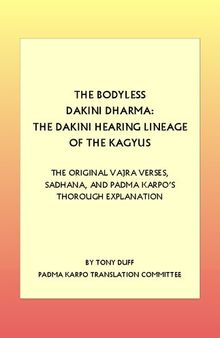دانلود کتاب The Bodyless Dakini Dharma: The Dakini Hearing Lineage of the Kagyus
by Tilopa, Naropa, Marpa Lotsawa, Milarepa, Rechungpa, Tiphupa, Padma Karpo, Tony Duff|
|
عنوان فارسی: دارما داکینی بدون بدن: دودمان شنوایی داکینی کاگیوس |
 دانلود کتاب
دانلود کتاب
 جزییات کتاب
جزییات کتاب
This book is a major exposition of the Bodyless Dakini teaching. A comprehensive introduction lays out the history of the teaching and its transmission, the principal figures involved, the texts of the system, and more. The body of the book includes translations of the root texts of the system and a major exposition of the system by the fourth Drukchen, All-knowing Padma Karpo.
The book was compiled by Tony Duff, well known teacher and translator, and long time scholar-practitioner of Kagyu and Nyingma lineages.
Two of the key teachings in the Kagyu system are the hearing lineage Chakrasamvara and Vajrayogini teachings which Tailopa obtained in person by storming the palaces of Chakrasamvara and Vajravarahi respectively. The instructions received from Vajravarahi became known as the dharmakaya teaching of the Bodyless Dakini and the teachings were passed down in what is known as the Dakini Hearing Lineage.
The Dakini Hearing lineage is one of the root teachings of the Kagyu. It is a very important teaching for any Kagyu practitioner but especially for anyone doing the Vajrayogini or Chakrasamvara practices.
This book is a major exposition of the Kagyu Dakini Hearing lineage teaching. It begins with a long introduction to the Dakini Hearing Lineage. The introduction gives the history of the teachings and its transmission, principal figures involved, the texts of the system, and a great deal of background information. It also tells the story of the criticisms levelled at the system by the Sakya Pandita and the very strong refutation of his criticisms by the famous fourth Drukchen, Padma Karpo. Three key texts of the system are presented in the body of the book. The first text is the very root of the Bodyless Dakini dharma, the original teaching spoken out of empty space by Vajravarahi to Tailopa, and the teachings that he in turn spoke out of empty space to Naropa. Following that, there is the original Indian sadhana for the practice. Then comes a very long explanatory text called The Thorough Explanation by Padma Karpo that shows the whole path of realization of these Vajrayogini teachings.
The book is a handbook of the Bodyless Vajrayogini teachings that contains much information that will be of interest to Vajrayogini and Chakrasamvara practitioners. The book will be of general interest to all Kagyu followers. It will also be of interest to Sakya followers and to historians interested in Sakya Pandita’s attacks on the Kagyu lineage. It will be of special interest to followers of the Drukpa Kagyu.
One of the interesting features of the book is the inclusion of a major text of Drukchen Padma Karpo. The Drukchens have been the heads of the Drukpa Kagyu for many centuries. All of them are known for their knowledge and realization. However, Padma karpo stands out as the great writer of the lineage. His works were so well-written and well-informed that he quickly became one of the greatest authors not just of his own Drukpa Kagyu lineage but of the Kagyu tradition as a whole. The work of his included in this book is one of his major works.
The book contains translations of the following texts:
The Root Vajra Verses called “The Dharma of the Bodyless Glorious Vajradakini”, one of the root texts from India that establishes the Bodyless Dakini dharma
The Sadhana Called “Bodyless Dakini”, another of the root texts from India that establishes the Bodyless Dakini dharma
“Tincture of Dharma”, A Thorough Explanation of the Bodyless Dakini Dharma by All-Knowing Padma Karpo, one of the most complete and important Tibetan commentaries on the original Indian Bodyless Dakini dharma texts.
About the translator
Tony Duff has spent a lifetime pursuing the Buddha’s
teaching and transmitting it to others. In the early
1970's, during his post-graduate studies in molecular
biology, he went to Asia and met the Buddhist
teachings of various South-east Asian countries. He
met Tibetan Buddhism in Nepal and has followed it since. After his
trip he abandoned worldly life and was the first monk ordained in his
home country of Australia. Together with several others, he founded
the monastery called Chenrezig Institute for Wisdom Culture where
he studied and practised the Gelugpa teachings for several years
under the guidance of Lama Yeshe, Lama Zopa, Geshe Lodan, and
Zasep Tulku. After that, he offered back his ordination and left for the
USA to study the Kagyu teachings with the incomparable Chogyam
Trungpa Rinpoche. Tony was very active in the community and went
through all possible levels of training that were available during his
twelve year stay. He was also a core member of the Nalanda Translation Committee. After Chogyam Trungpa Rinpoche died, Tony went to live in
Nepal where he worked as the personal translator for Tsoknyi
Rinpoche and also translated for several other well-known teachers.
He also founded and directed the largest Tibetan text preservation
project in Asia, the Drukpa Kagyu Heritage Project, which he oversaw
for eight years. He also established the Padma Karpo Translation
Committee which has produced many fine translations and made
many resources for translators such as the highly acclaimed
Illuminator Tibetan-English Dictionary. After the year 2000, Tony
focussed primarily on obtaining Dzogchen teachings from the best
teachers available, especially within Tibet, and translating and
teaching them. He has received much approval from many teachers
and has been given the titles “lotsawa” and “lama” and been strongly
encouraged by them to teach Westerners. One way he does that is by
producing these fine translations.




 این کتاب رو مطالعه کردید؟ نظر شما چیست؟
این کتاب رو مطالعه کردید؟ نظر شما چیست؟
